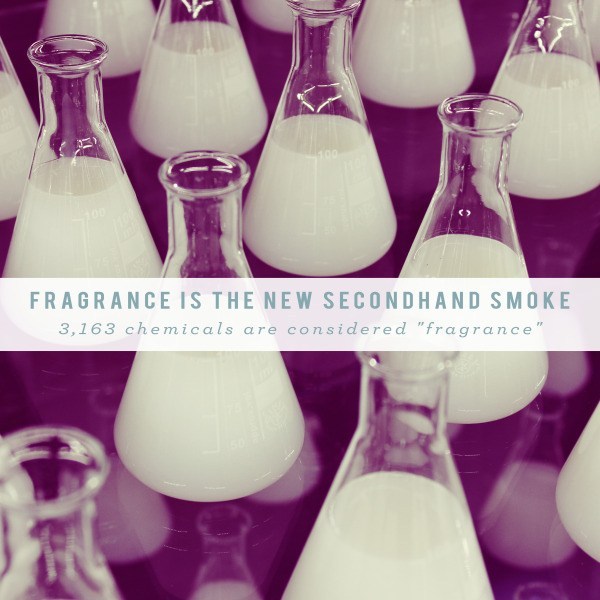Fragrance Is The New Secondhand Smoke


Surely you’re familiar with one of these scenarios: The Scented Candle That Won’t Go Away
You walk into a store full of scented candles. They smell so fresh and lovely, but a few minutes later, your nose starts to itch and you are starting to get a headache. You notice that you’re having a harder time focusing on anything and you start to feel light-headed. You end up buying a candle and leaving, feeling better as soon as you walk out the door. A few days later, the smell of your new candle is on everything: your coat, your car, the living room – even when it’s not lit. The headache just won’t go away and you start to feel worn down and tired.
The Mist That Never Disappears
You spray a fine mist of air freshener all over that musty pile of backpacks in the mudroom. Your second-grader grabs his bag, now slightly wet and sweet-smelling, and starts to do homework, but is having trouble focusing. He’s getting a headache and starting to whine about wanting to play outside. Meanwhile, the fake scent of flowers dissipates as it numbs sensory receptors in your nose and starts driving your puppy a little crazy. Eventually, you can’t smell it anymore, but you’ve ingested it through your nose, lungs, and skin.
Fragrance Is the New Secondhand Smoke
If you’ve experienced anything like this and connected the dots, you know how insidious synthetic fragrance can be. It’s only human to seek out pleasant smells and to try to eliminate unattractive scents from our environments. However, the immediate and long-term effects of synthetic fragrance exposure is hazardous to our health. Simply adding a pleasant smelling chemical to our bodies and air will not only affect our own health, but the health of the people (and pets!) who share the air with us.
What’s Actually in A Fragranced Product?
Today, fragrance is the elephant in the room. “Fragrance” or “parfum” on an ingredient list actually represents a trade secret fragrance recipe that could be made up of not just one or two chemicals, but hundreds of synthetic chemicals.4 These chemicals are selected from a reservoir of 5,000 ingredients.5 And of this large number of ingredients, none of them actually have to be disclosed or tested for safety.6
According to an Environmental Working Group (EWG) study, 72% of products with the ingredient “fragrance” contained endocrine disruptors called phthalates.7 Phthalates have been linked to diabetes, obesity, liver and breast cancer, hormone disruption affecting fertility and development as well as linked to ADHD and Autism in first and third trimester prenatal exposure. The National Academy of Sciences, working with an expert panel, stated that there may be cancer-causing chemicals in fragrance recipes.8 Unfortunately, because of secrecy and a lack of transparency in labeling, there is really no way for a consumer to make informed decisions about fragranced products.9
Up to 95% of these the synthetic chemicals used to make fragrance recipes are derived from petrochemicals.10 These particular ingredients are known (according to a 1991 EPA analysis) to cause cancer, birth defects, nervous system disorders, asthma, and allergies.11 To make matters even worse for the unsuspecting public, many products labeled as “unscented” are actually the fragranced product with the addition of another masking fragrance.12
What about Natural Fragrance or Essential Oils?
Unfortunately, the term “natural fragrance” or “essential oil” on an ingredient list does not necessarily mean it is safe. In a study analyzing 25 top selling products, researchers found that the “green”, natural, and organic fragranced products emitted just as many hazardous chemicals as regular fragranced products.13 That’s because most essential oils in consumer products are processed with a toxic solvent. In addition, essential oils containing terpenes such as pine and citrus oils react with ozone in surrounding air to create secondary pollutants such as formaldehyde, acetaldehyde, acetone, and ultrafine particles.14 To ensure safety, essential oils in products should be verified as organic and wildcrafted and extracted without solvents. 15, 16
How can we help protect the public?
Fragranced products are harmful to our health. Babies, children, the elderly, and those with cancer or other chronic illness are particularly at risk. The current demand for products that “smell good” reflects the misinformed innocence of consumers. Awareness of this issue is in its infancy, but the good news is that action is already being taken to pave the way in educating and protecting the public. The American Lung Association has created a fragrance-free policy for workplaces and for schools. Harvard University teaching hospital is a model for promoting fragrance-free policies in their hospital.17 Brigham and Women’s Hospital has even initiated a campaign for fragrance-free health care.
The best way for individuals to influence the fragrance industry is at the cash register – this will ultimately provide the impetus for change in the marketplace. Be proactive and only buy products that are unscented or have pure, safe essential oils. Even just removing all products with fragrance as an ingredient will immediately improve air quality in your home. Take charge of your family’s health and wellbeing – ditch these synthetics!
Join us to Clean Up Your Act. We are pledging the following:
- Don’t Buy Fragranced Products (unless contain pure organic essential oils)
- Ditch All Synthetic Fragrances
- Invest in Fragrance-Free, Nontoxic Alternatives





